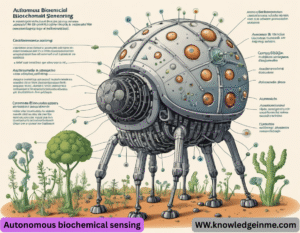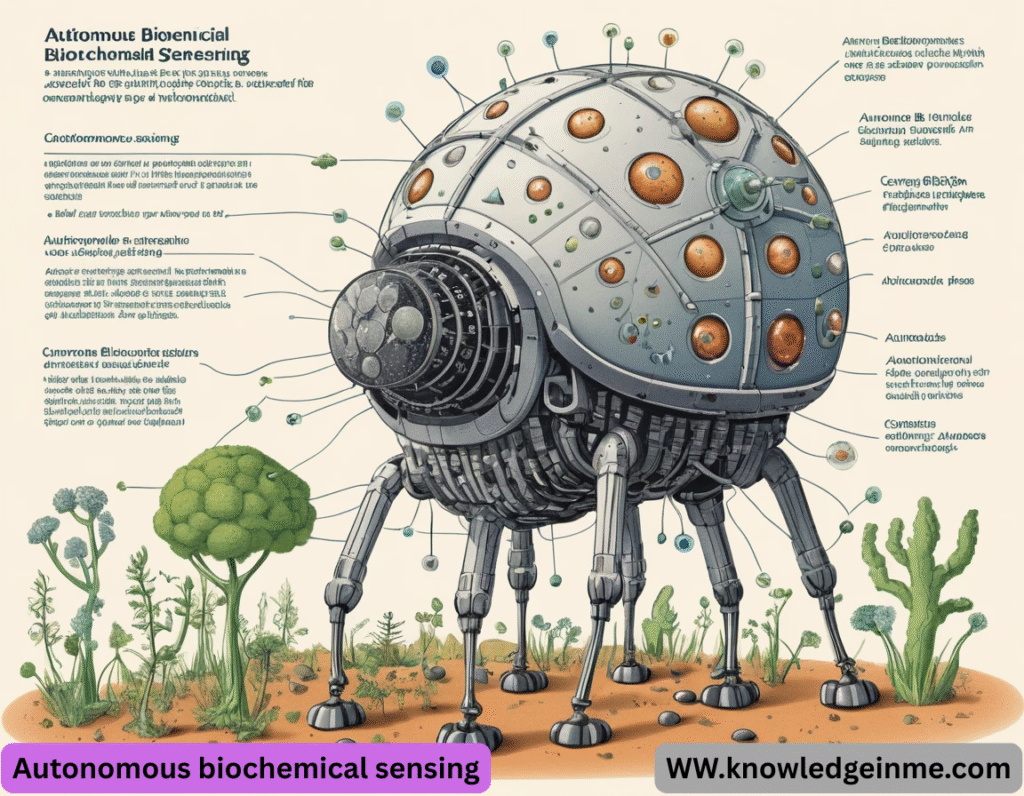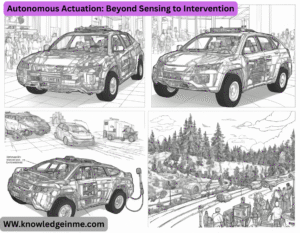Autonomous biochemical sensing refers to systems capable of continuously monitoring biochemical analytes (e.g., glucose, hormones, toxins, or pathogens) without human intervention. These systems integrate sensing, data processing, and sometimes actuation (e.g., drug delivery) for real-time decision-making. Here’s a breakdown of key aspects:

Core Components
Sensing Element:
- Biosensors: Use bioreceptors (enzymes, antibodies, DNA/RNA aptamers) to bind target analytes, coupled with transducers (optical, electrochemical, piezoelectric) to convert binding events into measurable signals.
- Wearable/Implantable Sensors: E.g., continuous glucose monitors (CGMs) with enzyme-based electrodes.
- Synthetic Biology: Engineered cells (e.g., bacteria with fluorescent reporters for toxins).
Autonomy Enablers:
- Power: Miniaturized batteries, energy harvesting (e.g., biofuel cells, piezoelectric).
- Data Processing: Onboard algorithms for noise reduction, calibration, and anomaly detection (e.g., edge AI).
- Closed-Loop Control: Integration with actuators (e.g., insulin pumps in diabetes management).
Applications
Healthcare:
- Diabetes Management: CGMs paired with insulin pumps (artificial pancreas).
- Sepsis Detection: Autonomous sensors monitoring biomarkers like lactate or cytokines.
Environmental Monitoring:
- Detection of pollutants (e.g., heavy metals, pesticides) in water/air using field-deployable sensors.
Biosecurity:
- Autonomous drones or lab-on-a-chip devices for pathogen detection (e.g., SARS-CoV-2 in wastewater).
Research:
- Lab-on-a-robot platforms for high-throughput drug screening.
Emerging Technologies
Nanomaterials:
- Graphene, quantum dots, or plasmonic nanoparticles enhance sensitivity/specificity.
Soft Robotics:
- Biocompatible, flexible sensors for long-term implantation.
AI/ML:
- Predictive analytics (e.g., hypoglycemia alerts) and adaptive calibration.
Synthetic Biology:
- Engineered microbial consortia that sense and degrade environmental toxins.
Challenges
- Power Constraints: Limited energy for continuous operation in implantable devices.
- Biofouling: Protein/cell accumulation degrades sensor performance over time.
- Calibration Drift: Environmental changes (pH, temperature) affect accuracy.
- Regulatory Hurdles: Strict validation requirements for medical devices.
Future Directions
- Self-Healing Materials: To combat biofouling or physical damage.
- Multi-Analyte Detection: Sensors that simultaneously monitor glucose, electrolytes, and hormones.
- Biodegradable Sensors: For transient monitoring (e.g., post-surgical recovery).
- Swarm Sensing: Networks of autonomous sensors collaborating for large-area monitoring.
Advanced Aspects of Autonomous Biochemical Sensing
Sensing Modalities & Innovations
- Autonomous biochemical sensors rely on diverse detection mechanisms, each with unique advantages:
Electrochemical Sensing
- Principle: Measures current (amperometry), potential (potentiometry), or impedance changes due to biochemical reactions.
Examples:
- Enzyme-based electrodes (e.g., glucose oxidase in CGMs).
- Molecularly Imprinted Polymers (MIPs) – Synthetic antibody mimics for detecting small molecules (e.g., cortisol, dopamine).
Advancements:
- Self-powered sensors using biofuel cells (e.g., glucose-powered sensors).
Nanoelectrodes for single-molecule detection.
Optical Sensing
- Principle: Detects changes in light absorption, fluorescence, or plasmon resonance.
Examples:
- Surface Plasmon Resonance (SPR) – Label-free detection of biomolecular interactions (e.g., antibody-antigen binding).
- Fluorescent nanosensors (e.g., quantum dots for pH, O₂, or ion detection).
Emerging Tech:
- Upconversion nanoparticles (UCNPs) – Enable deep-tissue sensing with near-infrared excitation.
- Smart contact lenses (e.g., Google’s glucose-sensing lens prototype).
Mechanical & Acoustic Sensing
- Principle: Measures mass changes or vibrational frequency shifts.
Examples:
- Quartz Crystal Microbalance (QCM) – Detects nanogram-level mass changes (e.g., viral particles).
- Surface Acoustic Wave (SAW) sensors – Used in gas/chemical detection.
Synthetic Biology-Based Sensors
- Principle: Engineered cells (bacteria, yeast) produce detectable signals (fluorescence, electrical) upon analyte exposure.
Examples:
- E. coli-based arsenic detectors in water.
- CRISPR-based diagnostics (e.g., SHERLOCK for viral RNA).
Autonomy & AI Integration
For true autonomy, sensors must process data in real-time and adapt to dynamic environments.
Edge Computing & Tiny ML
- On-device AI reduces latency and power consumption.
Applications:
- Predictive hypoglycemia alerts in diabetes.
- Anomaly detection in sepsis monitoring.
Closed-Loop Systems (Sense → Decide → Act)
- Example: Artificial Pancreas (CGM + insulin pump + control algorithm).
Next-Gen Systems:
- Neural implants detecting neurotransmitters (dopamine, serotonin) for depression therapy.
- Autonomous drug delivery for chemotherapy or antibiotics.
Self-Calibration & Drift Correction
- Challenge: Sensor performance degrades over time (biofouling, enzyme decay).
Solutions:
- Machine learning-based recalibration (e.g., using reference-free algorithms).
- Redundant sensor arrays for cross-validation.
Cutting-Edge Research Directions
Nanosensor Networks
- Nanoparticle swarms for distributed sensing in the bloodstream.
- DNA-based nanorobots (e.g., Harvard’s “origami robots” detecting cancer markers).
Bioelectronic Interfaces
- Organic electrochemical transistors (OECTs) – High-sensitivity, flexible biosensors.
- Neural dust – Ultrasmall wireless sensors for brain-machine interfaces.
Autonomous Environmental Biosensors
- Living sensors: Engineered algae detecting water toxins.
- Drone-based networks: Airborne biosensors for pandemic monitoring.
Biodegradable & Transient Sensors
Applications:
- Post-surgical monitoring (dissolve after healing).
Eco-friendly soil/water sensors.
Extreme Miniaturization: From Micro to Nano & Molecular Sensors
Single-Molecule Detection Limits
- Nanopore Sequencing (Oxford Nanopore Tech)
- DNA/RNA strands threaded through protein pores, with ionic current changes identifying bases.
- Next Frontier: Protein sequencing via nanopores (currently limited by noise).
- Zero-Mode Waveguides (ZMWs, Pacific Biosciences)
- Nanoscale holes that confine light to observe single enzymatic reactions (e.g., DNA synthesis).
- Challenge: Improving signal-to-noise for non-nucleic acid analytes.
Quantum Sensing in Biochemistry
Nitrogen-Vacancy (NV) Centers in Diamond
- Detects nanoscale magnetic fields from biochemical reactions (e.g., ATP hydrolysis).
- Potential: Monitoring metabolic states of single cells in real time.
- Plasmonic Hot Electron Injection
- Metal nanoparticles absorb light, generating “hot electrons” that trigger redox reactions for ultrasensitive detection.
Bio-Inspired & Bio-Hybrid Sensors
Organ-on-a-Chip + Autonomous Sensing
- Microfluidic “organs” (e.g., lung, liver chips) with embedded sensors
- Measures drug toxicity or immune responses in real time.
- Example: Gut-on-a-chip with bacterial quorum sensing detection.
Cyborg Cells: Living Sensors with Electronic Interfaces
Electrogenetic Bacteria
- Shewanella oneidensis generates current when metabolizing pollutants; wired to electrodes for autonomous environmental sensing.
Neuron-Silicon Hybrids
- Cultured neurons on CMOS chips detect neurotoxins via firing pattern changes.
Autonomous Actuation: Beyond Sensing to Intervention
Closed-Loop Biomedical Systems
- Real-Time Immunomodulation
- Implantable device detects inflammatory cytokines (e.g., TNF-α) and releases anti-inflammatory drugs (e.g., dexamethasone).
- Challenge: Avoiding immune over-suppression.
- CRISPR-Based “Smart Antibiotics”
- Sensor detects pathogen DNA → activates CRISPR-Cas9 to kill only harmful bacteria.
Synthetic Biology Feedback Loops
- Engineered Cells with Kill Switches
- Bacteria sense tumor markers → produce therapeutics → self-destruct after treatment.
Unconventional Power & Communication
- Energy Harvesting for Eternal Sensors
- Photosynthetic algae generate power for underwater sensors.
- Piezoelectric “Vampire Sensors”
- Harvests energy from blood flow/vibrations (e.g., piezoelectric nanowires in arteries).
Molecular Communication
Chemical “Wi-Fi”
- Use Case: Coordination of sensor swarms in the body.
Grand Challenges & Physics-Limited Barriers
The Biofouling Problem
Current Solutions:
- Zwitterionic coatings (super hydrophilic surfaces resist protein adhesion).
- Enzymatic “self-cleaning” (e.g., embedded protease coatings).
- Unsolved: Long-term (>1 year) stability in vivo.
Thermodynamic Limits of Detection
Landauer’s Principle in Sensing:
- Minimum energy required for a measurement at the molecular scale (~10⁻²¹ J/bit at 37°C).
- Implication: Ultimate limits for nano-biosensor energy efficiency.
Noise in Single-Molecule Sensors
- Sources: Thermal fluctuations, quantum decoherence, stochastic binding.
Mitigation Strategies:
- Bayesian inference algorithms for signal extraction.
- Quantum error correction (in NV center sensors).
Speculative Future Technologies
DNA-Based Nano factories
- Autonomous, self-replicating sensors that assemble from environmental nucleotides.
- Application: Martian soil toxicity monitoring.
Programmable Matter Sensors
- Shape-shifting nanoparticles that reconfigure to detect different analytes on demand.
Ethical & Existential Risks
- Gray Goo Scenario: Could self-replicating NANO sensors become uncontrollable?
- Cognitive Privacy: If sensors decode brain chemistry, who owns your thoughts?
- Evolutionary Pressure: Engineered sensing microbes altering ecosystems unpredictably.




